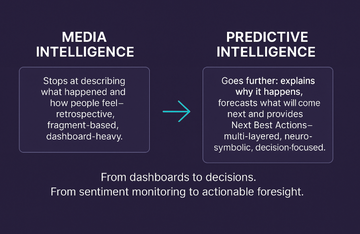Synergistic Leadership: Breaking Silos to Build the Future of Organizational Excellence
by Uwe Seebacher on Jan 12, 2025

In today’s hypercompetitive and interconnected business environment, the success of an organization is no longer defined solely by the strength of its individual departments. Instead, it hinges on the ability of these departments—communication, marketing, sales, and service—to work in concert, breaking down traditional silos to unlock their collective potential. Yet, this harmony does not emerge spontaneously; it requires deliberate effort, systems thinking, and, most importantly, effective leadership.
Two core dimensions emerge in the pursuit of organizational excellence. First, the modulation of synergies—a quantifiable framework that measures the value created through collaboration and integration across key functions. Second, the role of leadership, which serves as the linchpin for fostering collaboration, building trust, and driving sustained results. Without leadership that actively supports and enables synergy, even the most sophisticated frameworks falter.

Fig. 1: Driving Organizational Excellence Through Synergy and Leadership (Source: own illustration)
This article dives deep into the mechanics of synergy modulation, illustrating how mathematical modeling reveals the tangible value of collaboration. Simultaneously, we explore the critical role of leadership in not only driving this integration but also amplifying its results. Together, these elements form a roadmap for overcoming silos and building a more resilient, innovative, and competitive organization.
The Case for Synergies: Beyond Individual Contributions
Organizations have traditionally operated within a framework of specialization. Departments such as marketing, sales, communication, and service have long pursued distinct objectives, often with little regard for cross-functional alignment. While this siloed approach fosters focus, it inherently limits the organization’s ability to adapt, innovate, and grow.
In the article "Making collaboration across functions a reality," McKinsey discusses how cross-functional teams improved first-time-right delivery from 65% to over 80%, increased customer satisfaction, and reduced call center requests by one-third, leading to cost reductions. Another McKinsey article, "Experience-led growth: a new way to create value," notes that companies leading in customer experience achieved more than double the revenue growth of "CX laggards" between 2016 and 2021, emphasizing the correlation between customer experience and revenue growth. The core reason? Synergies.
Synergies represent more than the sum of departmental contributions. They are the multiplicative effects that arise when information, strategies, and processes are shared seamlessly across functions. These effects manifest in improved customer experiences, operational efficiencies, and faster innovation cycles. However, as organizations pursue these outcomes, they face critical questions: How can synergies be measured? What conditions maximize their impact?
Modeling Synergies: The Formula for Success
At the heart of synergy lies a quantifiable relationship between the strategic importance, process maturity, and technological readiness of individual departments. These factors combine to generate an organization’s collaborative potential.
The formula for synergy is as follows:

Fig. 2: Modulation for Synergies (Source: own illustration)
Breaking Down the Formula:
- Strategic Weighting (Wi): The importance of each department in achieving organizational goals.
- Process Maturity (Fi): The extent to which workflows and operations are optimized.
- Data and Technology Readiness (Di): The availability and quality of systems and data.
- Cultural Cohesion (Ki): The level of alignment and trust within and across teams.
- Synergy Factor (Si(t)): The time-sensitive impact of collaboration, which grows as integration deepens.
- Leadership (L): The amplifying factor that ensures collaboration flourishes.
When these elements align, the organization experiences exponential growth in efficiency and effectiveness. Conversely, when one element—especially leadership—lags, the entire system suffers. Synergies arise through the multiplication of the mentioned factors. The better the leadership (L), the more effectively synergies unfold. Integration Costs reduce (CIntegration) the net effect, especially in the early phases of collaboration, where investments in alignment, technology, and training are highest.
Leadership as the Amplifier of Synergies
Leadership is the invisible force that either enables or stifles synergy. It is not enough for departments to possess strategic importance or mature processes. Without leadership actively driving integration, the potential for collaboration remains unrealized.
Leaders play three critical roles in synergy creation:
- Visionary Alignment: Leaders define a shared purpose that transcends departmental goals, creating a unified direction for the organization.
- Cultural Integration: Through trust-building and open communication, leaders break down barriers that hinder collaboration. They set the tone for interdepartmental respect and cooperation.
- Resource Stewardship: Effective leaders ensure that the necessary tools, time, and training are provided to enable synergy.

Fig. 3: Empowering Leadership for Organizational Synergy and Success (Source: own illustration)
In the article "What does effective leadership transformation look like," Deloitte discusses the importance of managing cross-functional conflicts and dependencies as key to execution during transformations. Another Deloitte article, "Teaming your way through disruption," notes that operating via cross-functional teams poses new management challenges, and more than half of survey respondents cite problems with team alignment and an unsupportive culture as the biggest barriers facing such teams.
The Impact of Leadership Quality on Synergies
The formula for synergy underscores the critical role of leadership. Let us consider two scenarios:
Scenario 1: Effective Leadership (L=1)
With visionary leadership in place, the organization maximizes its collaborative potential. In this scenario, cultural cohesion () and the synergy factor () reach their full potential, leading to a measurable increase in efficiency and innovation.
Scenario 2: Ineffective Leadership (L=0.5)
When leadership is absent or misaligned, the synergy factor drops. Integration becomes fragmented, cultural cohesion deteriorates, and departments revert to siloed thinking. This results in a significant loss of synergy, often reducing effectiveness by 15–30%.
Quantitatively, an organization with a synergy potential of 2.5 units under effective leadership may see this drop to 2.0 units or lower when leadership fails—a stark reminder of the importance of strong, collaborative leadership.
Practical Example: The Impact of Leadership on Synergies
Assumptions:
Consider an organization with four key departments: Communication, Marketing, Sales, and Service. Below are the factors for each department:


Fig. 4: Sample Calculation of Synergies and Leadership (Source: own illustration)
From Silos to Synergies: A Leadership-Driven Transformation
What does this mean for organizations seeking to overcome silos?
- Invest in Leadership Development: Equip leaders with the skills to foster collaboration, manage conflict, and drive integration.
- Build Systems for Collaboration: Use technology to break down barriers and facilitate seamless communication between departments.
- Monitor and Measure Synergies: Continuously evaluate the effectiveness of integration efforts using metrics derived from the synergy formula.

Fig. 5: Achieving Organizational Synergy (Source: own illustration)
Ultimately, the journey from silos to synergies is one of intentional leadership. By recognizing the pivotal role of leaders in driving collaboration, organizations can unlock their full potential and thrive in an increasingly competitive landscape.
Conclusion: Leadership at the Core of Synergy
The modulation of synergies reveals a powerful truth: the strength of an organization lies not in its individual parts, but in their integration. Leadership amplifies this integration, turning potential into performance. As we face the challenges of the modern business environment, the message is clear: synergies require leadership, and leadership is the engine of success.





